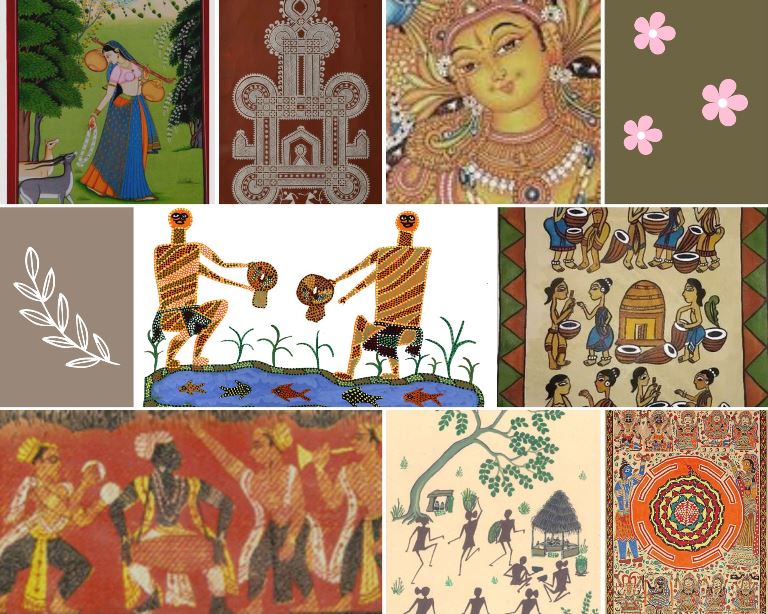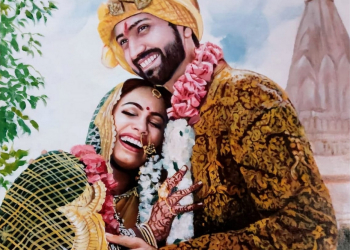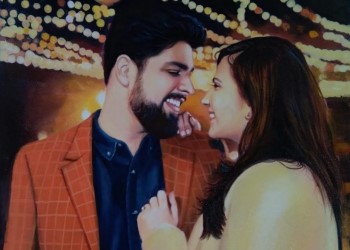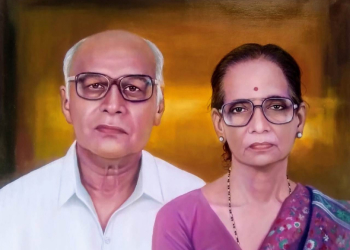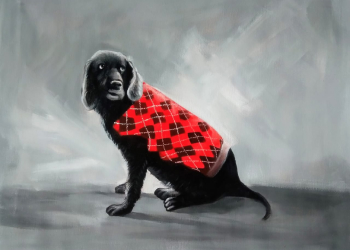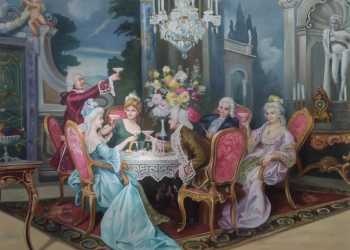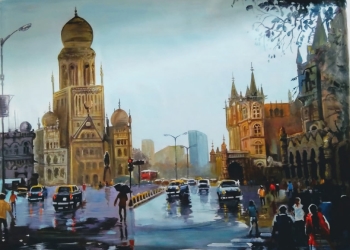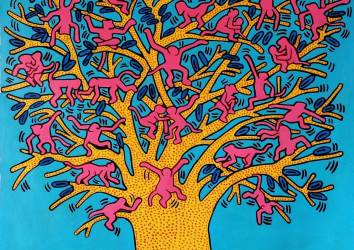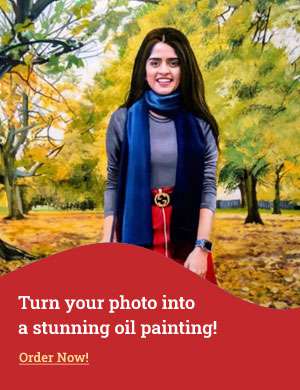India always had a rich tradition and culture of arts and paintings. While Western art of making oil paintings and portrait paintings has become popular among mainstream artists and art patrons recently say in the last 500 years or so, India’s traditional artists have been around far longer and continue making their art in the traditional way which they had been doing for thousands of years.
Indian folk arts and paintings are as varied in style, composition, and color as the country herself. Though distinct from each other in style and appearance, there is an innate sense of Indianness that comes out palpably in each of the different schools of folk art and folk paintings.
In this post, we cover some well-known and not-so-well-known traditional handmade paintings and tribal folk art of India.
The handmade miniature painting of Assam
The Assamese miniature painting style is one of the oldest traditional painting styles of Indian folk art. Harshcharita (biography of King Harsha) written in Sanskrit by Banabhatta in the 7th century AD, informs us King of Kamrupa, ancient Assam, gifted Harshavardhan, King of Northern India, "volumes of fine writing with leaves made from aloe bark and the hue of ripe cucumber."
The paintings done as a part of a manuscript were made on sanchipat (a local writing material) or tulapat (paper pulp made from Tula leaves) with written descriptions, are collectively called the Assam school of miniature paintings also known as Satriyā School of Painting,
The Khanikars (painters) created them under the guidance of their patrons and scholars. The paintings mainly illustrate various stories of Gods and Goddesses from the Hindu epics Mahabharata, The Ramayana, and the Puranas.
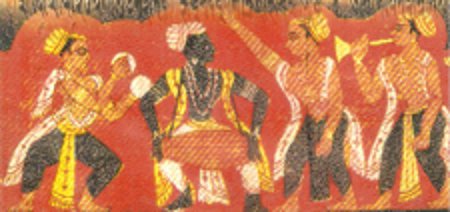 Handmade Assamese Miniature Painting
Handmade Assamese Miniature Painting
Order Your Portrait Painting from Photo today!
The composition and layout of the painting are in horizontal (landscape) format unlike in other parts of India where the miniature paintings are in vertical (portrait) format
The background of the paintings is almost always monochrome red with no details. The rest of the Ālekhya-sthāna, (space left in a manuscript for an illustration) is painted green on which the actual painting is made, narrating the various characters and subjects. The paintings don’t have any foreground or background and are usually flat.
The Assamese miniature paintings are usually 1 inch to 24 inches in height and 8 inches to 12 inches in width. The manuscript paintings are categorized into 1. Sattriya or Sankari style, 2. Gadgayan or Royal Style 3. Darrangi or Folk Style 4. Tai Style.
The Assamese miniature oil paintings make excellent home décor items, which give the interiors an authentic look. They also make great gifts for any occasion, be it a wedding gift or an anniversary gift, or a housewarming gift.
The handmade Bhil paintings of Madhya Pradesh
Bhil paintings are one of the oldest art forms in India. The traditional handmade paintings are made by the Bhil community of India. One of the largest communities of Adivasis in India, the Bhil community mainly resides in Madhya Pradesh, Chhattisgarh, Gujarat, Maharashtra, and Rajasthan. The community traces their ancestry back to the days of antiquity, to Valmiki, author of the Indian epic Ramayana, and Eklavya, the famed archer mentioned in the great Indian epic Mahabharata.
Bhil paintings are possibly one of the oldest art forms in India. The art form has been practiced for over two millennia in the country.
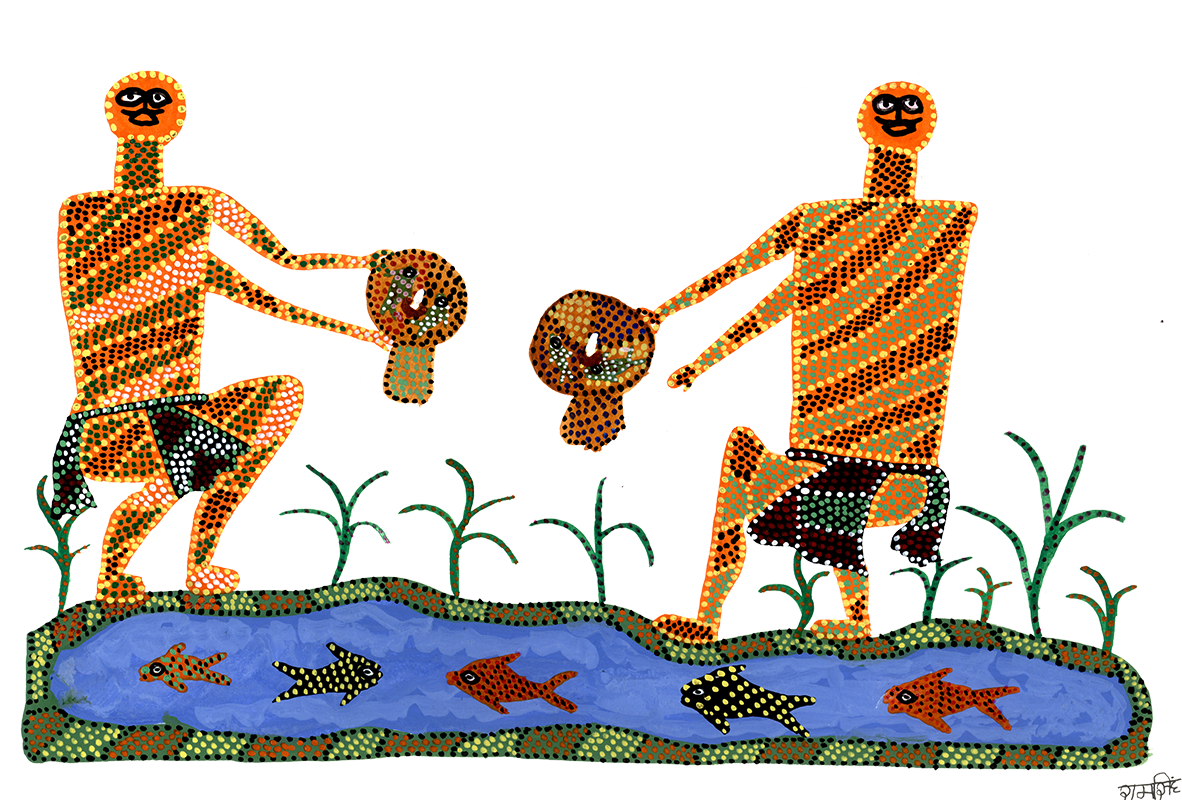 Handmade Bhil painting of Madhya Pradesh
Handmade Bhil painting of Madhya Pradesh
The beautiful images of Bhil paintings are painted with neem sticks and other twigs and natural dyes. The brilliant colors of the painting are made from pigments from turmeric, flour, vegetable dyes, and oil. The paintings are composed of large shapes of characters filled with bright colors and overlaid with multi-hued dots. Somewhat the technique of Bhil painting resembles the pointillism technique used in Western art. However, that’s where the resemblance to pointillism ends. Stories of everyday life, Gods & deities, religious occasions, festivals, and prayers are depicted in the Bhil paintings. The paintings are also offered to Gods and Goddesses during important festivals.
Over time Bhil painting has modernized with clay and natural dyes replaced with canvas, acrylic paints, and oil painting. The Bhil paintings have now moved from villages to the city as people use them for interior décoration and home décor. Many aesthetically inclined art lovers buy them as anniversary gifts, wedding gifts, birthday gifts, retirement gifts, and other life occasions.
 Bhuri Bai receiving Padma Shree Award
Bhuri Bai receiving Padma Shree Award
Well-known Bhil artist, Bhuri Bai, was awarded Padma Shri by the President of India in 2021 for her work in Bhil paintings. Ladoo Bai, Sher Singh, Ram Singh, and Dubu Bariya are other well-known Bhil artists.
Order Your Custom Handmade Oil Portrait Painting from Photo today
The handmade Bhojpuri paintings of Uttar Pradesh (UP)
Bhojpuri paintings are thought to have originated in the ancient region of Magadha now in the state of Bihar, India. It is said to date back to 1300 BC to the era of Ashoka, the third emperor of the Mauryan dynasty.
Bhojpuri paintings have two major styles, Khobar paintings, and Pidhya paintings. Khobar style symbolizes love and gratification and is traditionally painted on the eastern wall of newly married couples depicting Shiva and Parvati the divine couple signifying powerful union and stable marital life.
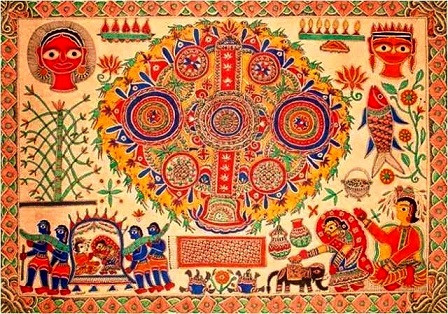 Bhojpuri Painting
Bhojpuri Painting
Pidhya painting depicts everyday life like farmers harvesting, and motifs like snakes, birds, flowers, and leaves. Pidhya painting also portrays the natural bond between siblings.
The paintings are made in bright natural colors. Red, Yellow, Black, and white are the prominent shades used in making the paintings.
The Bhojpuri handmade oil paintings of the Khobar type make an ideal anniversary gift and wedding gift for couples.
A few prominent Bhojpuri artists are Kamlesh Kundan, Roshan Roy, Vijay Mehta, Koushalesh Kumar, and Rupesh Kumar Pandey
The handmade Chittara art of Karnataka
Chittara is an indigenous art form that originated in the Deevaru community who reside in and around Sagara in the ranges of the Western Ghats in North Kanara.
Chittra drawings are intricate geometric patterns, representing auspicious ceremonies and rituals of life. The size of the paintings is usually 36 inches in height and 24 inches in width. The paintings are made with natural color pigments made from rice paste for white, roasted rice for black, yellow seeds (gurige), and red earth. And the brushes are made of the fibers of the pundi plant.
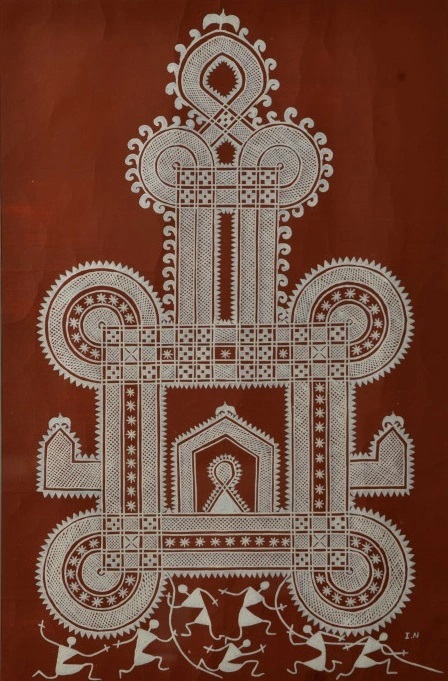 Chittara Painting
Chittara Painting
About Chittara painting, National award-winning artist Ishwar Naik, says “Has an unbroken connection with stone age paintings. The motifs are derived from everyday life, birds, trees, animals, bride and groom, and symbols of fertility.
Since handmade Chittara paintings are considered auspicious for the family, especially in Karnataka, they make beautiful home décor artifacts and are often gifted as wedding gifts and anniversary gifts to newly married couples.
Handmade Art Reproductions & Landscape Paintings
The handmade Chitrakathi painting of Maharashtra
Chitrakathi paintings are an indigenous form of storytelling combining the visual form of paintings, Chitra, and story, Katha. And the paintings form an integral part of the traditional oral storytelling performance undertaken by the storytellers of Maharashtra (Paithan and Pinguli), Andhra Pradesh, and Andhra Pradesh. The styles of these paintings are still present in and around Kudal town in the Sindhudurg district of Maharashtra.
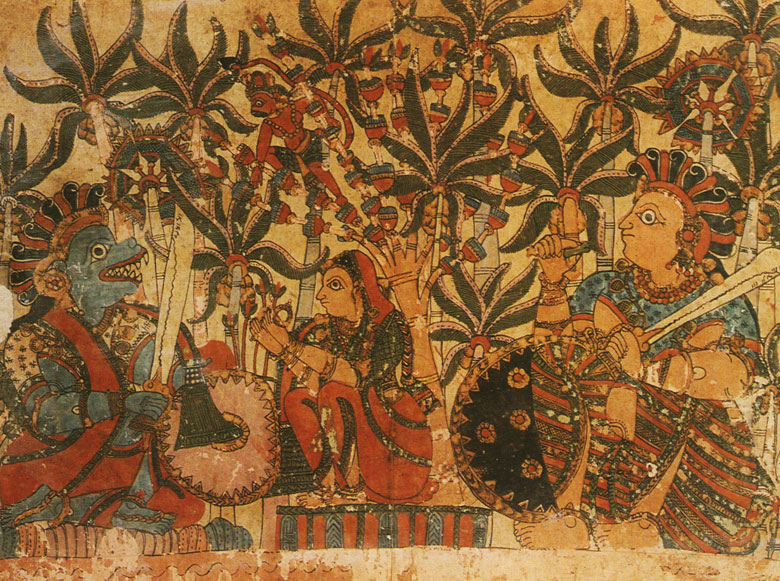 Handmade Chitrakathi Painting
Handmade Chitrakathi Painting
The stories are depicted as handmade paintings on handmade paper using natural colors and dyes. The Thakkar tribal community of storytellers practices this almost extinct art form. The size of the painting was standardized as appropriate for the village audience size. All paintings of one story were kept together in a single bundle called pothi. Usually, the number of paintings depicting one story exceeds 50. The song is set first by the artist, and the paintings are made after, in support of the story. The artist performs by narrating the story in song form while showing the paintings, which serve as a visual aid.
The style of the paintings is a fusion of the miniaturist painting style with the muralist painting style of the temples, and is very similar to Ellora's style of painting.
The paintings depict regular village life, stories from the Epics Mahabharata and Ramayana
Jadopatia painting of Jharkhand
Jadopatia paintings are an art form practiced in the Nawasar village of Dumka district in Jharkhand, India. The word ‘Jadopatia’ is derived from the word ‘Jadu’, the community which creates the paintings, and ‘Patia’ which is the scrolls on which these paintings are created. The families that create these paintings are titled ‘Chitrakar’. Chitra is Sanskrit for image, and ‘Kar’ stands for the performer. Thus ‘chitrakar’ means image makers.
The themes of these handmade paintings tell the stories from Ramayana and Mahabharata, of life after death, the origins of life, festivals, and other rituals. Among all these stories, the life-after-death story plays the most significant role. When there is a death in the Santhal family, the Chitrakars reach the house where the death has occurred and show a painting of a dead person without pupils of the eyes, depicting the pains of the departed with appropriate commentary on the suffering soul. On receiving a small donation from the deceased’s family, the Chitrakar makes the pupils of the eyes, thereby making the departed soul happy. This ritual gives solace to the family of the deceased. In modern days, many families prefer to make memorial portraits to commemorate the somber occasion.
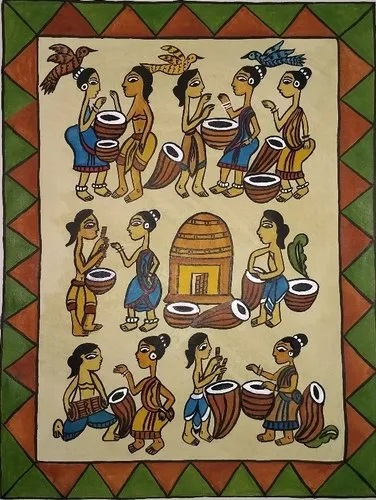 Jadupatua Painting
Jadupatua Painting
The paintings are made of natural colors prepared from plants and minerals. They are in the format of vertical scrolls. In the current day, oil painting is also used to make them.
The vertical format, rustic and primitive style of Jadopatia oil paintings is gradually garnering the attention of the urban middle class, who use these artifacts for home décor purposes and as housewarming gifts, anniversary paintings, and wedding gifts.
Kalamezhuthu, hand painting of Kerala
Kalamezhuthu is an ancient ritual art form practiced in Kerala, during the festivals of Bhadrakali temples and on special occasions in Ayyappankavu (temples of Lord Ayyapa) and SarppaKavu (groves sacred to the snakes). Kalamezhuthu is done to propitiate the deities and to bring prosperity.
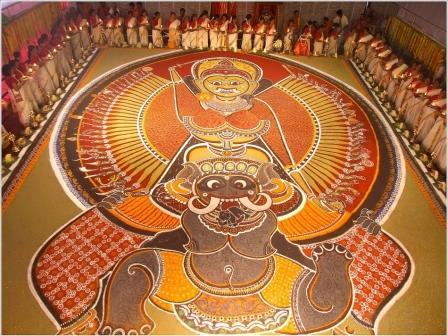 Handmade Kalamezhuthu Pattu Drawing
Handmade Kalamezhuthu Pattu Drawing
In the ritual art form, the deity’s form is drawn on the floor using five colored powders. The main deities depicted are Bhadrakali, Ayyapa, Vettakkorukan (Shiva Putra), Darika, and Sarpa Naga. Specific shlokas are sung fifteen minutes before the commencement of the drawing. The actual drawing takes about two to four hours to complete. The colors used are derived from natural sources, like charcoal, rice, turmeric, lime, and green to make the five color powders, black, white, yellow, red, and green.
Once the rituals for the deities are completed, the Kalamezhuthu is ceremonially erased and colored powder is distributed to the devotees as blessings of good health and prosperity. In contemporary times, Devotional paintings have gained popularity as it allows the devotee to worship their favorite deity at home.
Kangra painting, the handmade art of Himachal
The name Kangra painting has come from the erstwhile princely state of Kangra, a small hill state in the lower Himalayas in Kangra valley, presently located in Himachal Pradesh in India, which patronized the art form in the mid-18th century.
The Kangra art centers developed in Gueler, Nurpur, Bilaspur, Chamba, and Bashohi.
The themes of the handmade Kangra paintings are the Shringara rasa, romantic love driven by the Bhakti movement, and the spiritual experience of the love story of Radha Krishna.
The painting style of Kangra painting is naturalistic and with a great deal of detail. Another feature is the display of verdant greenery in all the paintings, a reflection of the natural greenery of the surroundings found in the lower Himalayas.
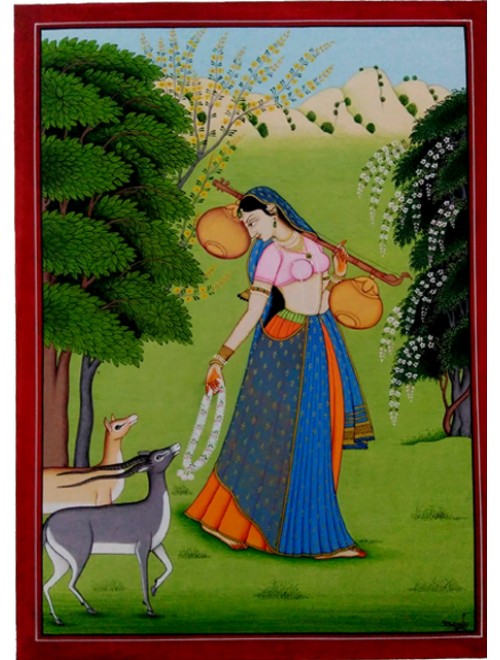 Handmade Kangra Painting
Handmade Kangra Painting
The Kangra paintings are mainly composed of primary colors. The colors used in making the paintings are derived from natural sources like minerals, fruits, flowers, and vegetables.
The unique styling of the handmade Kangra paintings, their elegant symmetry, and their simplicity have attracted the attention of art lovers across the world. They are used to beautify the interiors, as home décor pieces, and for gifting purposes for occasions such as anniversaries, weddings, and housewarming gifts.
The Kangra paintings have been accorded the GI Tag (Geographical Indication Tag) for protection against fake Kangra Paintings.
The folk art of Kavad painting of Rajasthan
The Kavad style of painting is practiced by the Kumawat community in a small village of Bassi, in the Bhilwara district near Udaipur, Rajasthan, India. The Kawadiyas trace their ancestry to ‘Shravan’ a young boy in Ramayan, who was accidentally killed by King Dasharath, father of Lord Ram, while he was carrying his blind parents in a ‘kawadi‘ on his shoulders to worship in the temple. His last dying wish to King Dasharath was to bring the temple to his parents so they can worship the Gods. The concept of Kavad started from here.
Kavad is a small portable wooden cabinet, which has 10-20 handmade painted panels that tell different stories and also double up as a portable temple. The stories are from episodes of Ramayana and Mahabharat and narrate incidents from the lives of Ram, Krishna, and Vishnu. The stories are narrated by the Kavadia Bhatt community, who travel from village to village to tell their tales with the help of the Kavad box, which also serves as a portable temple. As the stories progress, different painted panels are unfolded to serve as a pictorial representation of the story. At the end of the story, the innermost panel is revealed, allowing the listeners (jajmans) to have Darshan of the presiding deity.
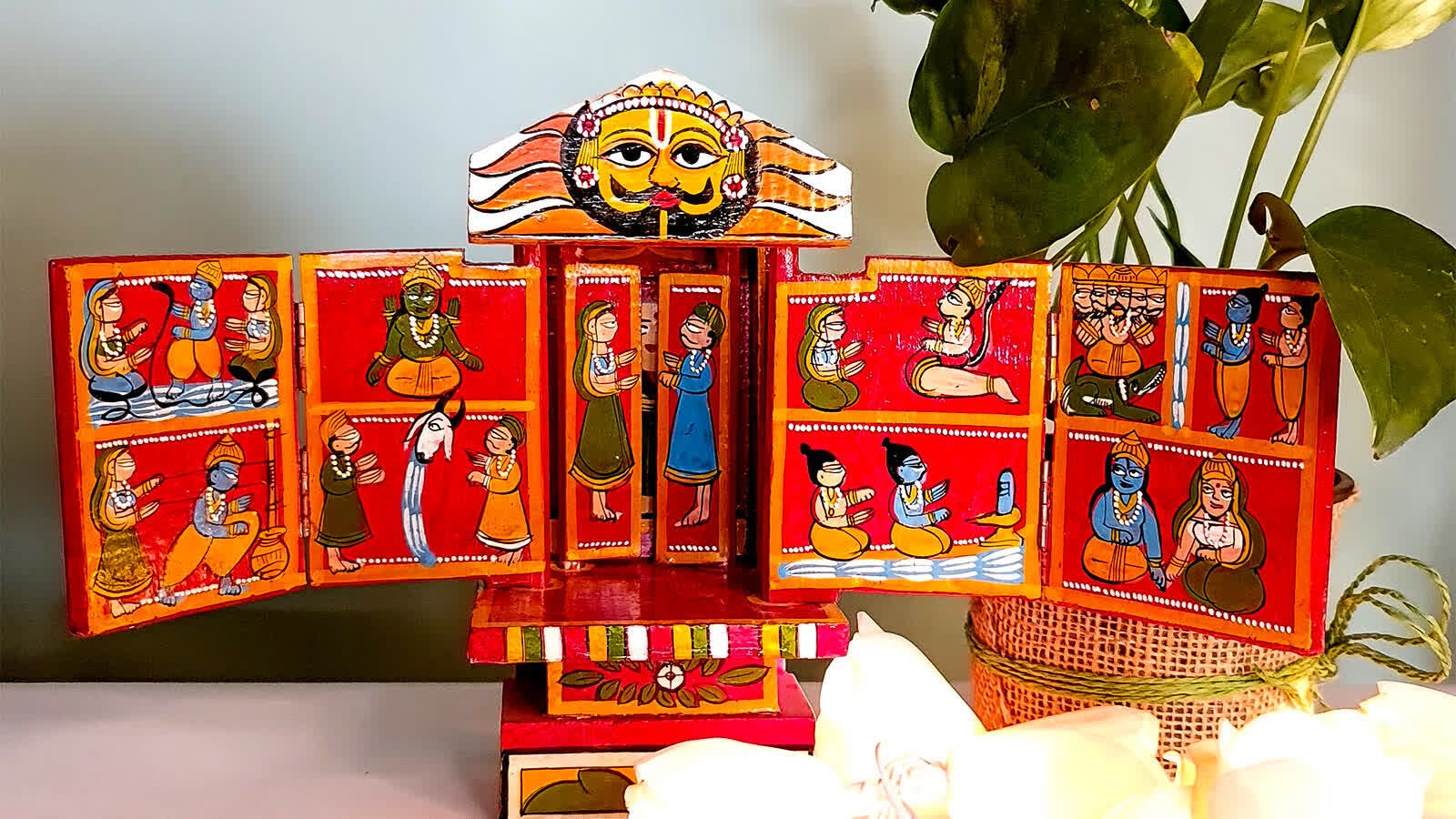 Kavad Painting
Kavad Painting
The Kavad is made by the suthar(local carpenter), who fashions it out of local wood. The boxes and panels are first made, then color is applied to them. Then the designs and figurines are made on the panels. Once all the painting work has been completed; the panels are assembled into a Kavad.
Kavad is a dying art form. These days Kavad is used as a home décor item for knick-knacks or used for gifting purposes like wedding gifts, anniversary gifts, and housewarming gifts.
Handmade Kerala mural painting
Kerala handmade mural paintings are frescoes painted on the walls of ancient temples and palaces. They narrate various Hindu mythologies and stories. The murals of Kerala are known for their strong characterization and bold use of bright colors and are known for their arresting beauty, symmetry, clarity, and linear accuracy. The style of Kerala paintings is strikingly similar to the paintings found in the Ajanta cave murals made in the 2nd century - 8th century AD. Made only with natural pigments, the colors represent the qualities of the three Gunas-sattva, rajas, and tamas.
The traditional colors used in Kerala mural painting are yellow, green, red ochre, white, black, and sometimes blue. The traditional forms of Kerala murals use natural pigments and vegetable colors. The subjects for the painting are made by following the various Vedic texts, drawn strictly from the description in the invocatory verses or dhyana slokas and not based on the artist's imagination. The basis of these paintings is described in Sanskrit texts, 'Chithrasoothram, (Chitrasutra is a part of the VishnuDharmottara Purana, a book written in Sanskrit about 1500 years ago.)
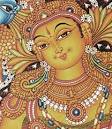 Handmade Kerala Mural Painting
Handmade Kerala Mural Painting
There are six stages to making a Kerala Mural painting. In the first stage, Lekhya Karma, the sketching of the mural is done. In the second stage, Rekha karma, the outlines of the drawing are enhanced and made more prominent. In the third stage, Varna karma, the colors are filled in. The coloration process follows a stipulated procedure. Divine (Satvik) and noble characters are filled with green, characters who are inclined towards wealth and power (Rajasic) are colored in shades of red, Tamasic (lazy and inert) characters are painted in white and asura (demon) characters are painted in black. In the fourth stage, Vartana Karma, the shading of the characters is done. In the fifth stage, Lekha Karma, the final bold outlines of the painting are usually made in black. In the sixth and final stage, Dvika karma, the final finishing touches are given to the painting.
While in the traditional method, only natural organic pigments and colors were used, the paintings were made on the walls of temples and palaces, in modern days, oil and acrylic is also used, and the paintings are made on paper, canvas, boards, and other surfaces.
The arresting look of the handmade Kerala mural oil paintings lends a bold outlook to interiors when used as home decor pieces, and as such, they have become very popular with art patrons and art collectors who use them as housewarming gifts, anniversary gifts, wedding gifts, and even birthday gifts.
The handmade paintings of Kurumba, Tamil Nadu
Kurumba painting is an ancient tribal art form practiced by the Kurumba tribal community, found in the Nilgiri hills in Tamil Nadu, India. The earliest recorded reference to the Kurumba tribes of Nilgiri is found in the work, An Account of the Primitive Tribes and Monuments of the Nilgiris by James Wilkinson Breeks, published in 1873. They were mentioned again by Edgar Thurston in his book, Castes, and Tribes of Southern India, published in 1909.
The Kurumba community believes that the 3000-year-old rock paintings done in Eluthu Paari, near their dwelling place, at Vellarikombi located in the Kothagiri region were done by their ancestors.
The Kurumba art describes the everyday life of the tribal community of Kurumba, like weddings and rituals, men harvesting honey, women drying food grain, worship of Mariamman, and other rituals and celebrations.
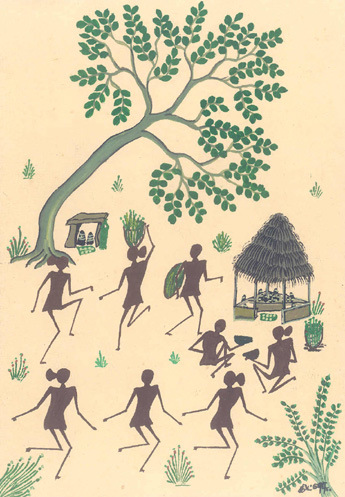 Kurumba Painting
Kurumba Painting
Kurumba painting is made on handmade paper, using natural colors. Yellow, brown, and maroon color is made from the gum or sap of the Kino tree, green from the pigment extracted from the leaf of ‘Kattaikeerai’ or ‘kattaigida’ plant, Reddish‐brown (semm‐manna), and white colors (budhi‐manna) are derived from various types of soils collected from the surrounding areas. The colors are mixed with water and then using brushes, the paintings are made on handmade paper boards.
A well-known artist of the art form is Krishna, who says that his handmade artworks are sold by the local stores, to tourists and city dwellers and are mainly used for home decor purposes and for gifting on occasions like marriage, anniversaries, and other life events.
Folk art of Bengal - The Masan Painting
Masan painting is an art form practiced in Uttar Bangla, the Northern part of West Bengal, parts of Assam, Meghalaya, Eastern Nepal, and Bihar. The word ‘Masan’ is derived from the Bengali word, ‘Shoshan’ for cremation ground. In North Bengal, it is practiced by the Rajbanshi community who are the patrons of the Masan painting art form, also known as ‘Masan Chitrakala’ in Bengali. The art form is used by the Rajbanshi community to perform the Masan Pooja.
The history of Masan deities is linked with the ancient Bon religion of Tibet in North Bengal. The Tantric Buddhist deities are considered neither Gods nor demons and were meant to be worshiped in a crematorium or near cremation grounds.
The early paintings of Masan deities were made on silk or cloth similar to Tibetan Thangka paintings and were said to be endowed with healing powers. Masan paintings were dedicated to the healing of certain diseases and to praying to the Masan Devta, who the Rajbonshish believe exists in ‘Rudra’ form.
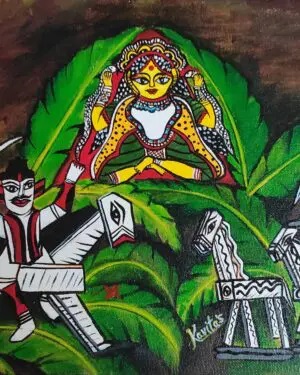 Masan Painting of Bengal
Masan Painting of Bengal
The artists who make the Masan paintings are called Malakar, (garland makers). The paintings are made with handmade brushes and natural colors, with different motifs, and structured with shola (a local wild plant). The motifs have special significance to the Rajbonshi people, for curing the sick, celebrating a wedding, and the birth of a child. In its modern form acrylic and oil painting is also used to make the Masan paintings.
With the closing of the silk route, the influence of Tantric Buddhism waned and the practice is now found in certain districts of Jalpaiguri, Coochbehar, and Darjeeling
Just like the Kerala mural paintings, the handmade Masan paintings have a bold and provocative style that naturally lends itself as a home decor piece to liven up the interiors. They also make unique gift items fit for gifting as retirement gifts, housewarming gifts, and anniversary gifts.
Nirmal painting, the handmade art of Telangana
Nirmal paintings are an art form practiced in the Nirmal town in the erstwhile Adilabad district now renamed Nirmal district in Telangana, India, and in Hyderabad in Andhra Pradesh. The artists and artisans who work on creating these handmade oil paintings are known as ‘Naqash’. Nirmal paintings trace their origins to the Kakatiya dynasty, which ruled Telangana, Andhra Pradesh, Eastern Karnataka, and the Southern Orissa region from the 12th century to the 14th century.
The painting style of Nirmal paintings has unmistakable influences from the Kangra Painting style, Ajanta paintings, and Mughal miniatures. The Mughals were particularly fond of the handmade Nirmal paintings and patronized the art form. In contemporary times, the art form was patronized and promoted by the Nizams of Hyderabad.
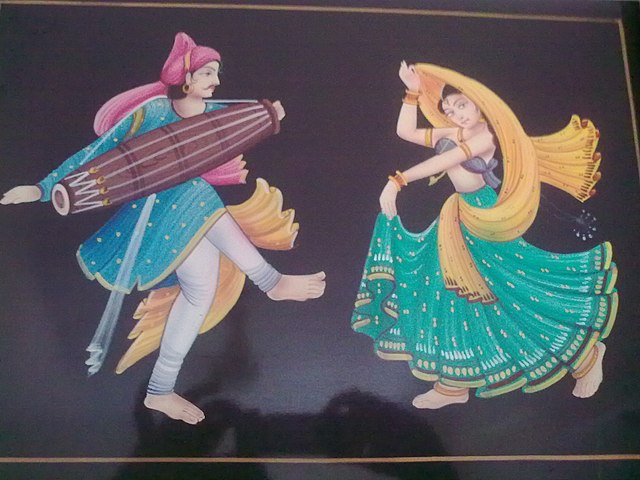 Handmade Nirmal Painting
Handmade Nirmal Painting
The Nirmal paintings traditionally deal with the themes from the epics Mahabharata and Ramayana, panoramic landscapes, birds and trees, to dancing ladies.
The paintings are handmade by using lacquer, acrylic, and oil painting and brushes on a teak wood or the soft white Puniki wood frame. Shades of gold and gold leaves are used frequently in making these paintings which lend the paintings a golden hue and gives an elegant finish and adds luster to paintings.
The attractive handmade Nirmal paintings are used as home decor pieces to spruce up the interiors and as gift items for special occasions such as wedding gifts, anniversary gifts, housewarming gifts, and retirement gifts.
Mandala art
“Mandala” is a Sanskrit word used to refer to a painting, or a diagram, with geometric patterns and designs, usually circular in construction, imbued with symbolic meaning. Mandalas are artistically beautiful and can be used to depict stages of the spiritual journey. The most well-known type of mandala is those made of colored sand that can take weeks to create. In certain meditation practices, the offering of a sand mandala ends with the mandala being wiped off to signify impermanence.
The origins of the Mandala are rooted in Hinduism and Buddhism. Mandala imagery first appeared in the Vedas (c. 1500-500 BC), and Buddhist monks are believed to have taken it outside India through the Silk Road. By the 6th century, Mandalas were recorded in Tibet, China, Korea, Japan, and Indonesia.
While used as a spiritual tool, Yantra, to aid spiritual awakening and practice, it has also become a form of creative expression in the hands of artists. Modernist Indian painter SH Hazra has used Madala forms extensively in his oil paintings and artworks with his Bindu series, which brought him global acclaim. Other well-known artists to have used Madala in their artworks are Sohan Qadri and Prafulla Mohanty.
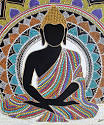 Mandala Painting
Mandala Painting
While Madala was earlier made with colored sand, to depict the impermanence of life, in contemporary times Mandala is made as oil paintings and handmade artworks. These artworks are used as home décor pieces to add a sense of mysticism to the interiors, and also for gifting.
Madhubani paintings, the handmade art of Bihar
Madhubani painting, also known as Mithila paintings, is one of the oldest folk art forms of India. Named after the Madhubani district in Bihar, where the art form originated and is practiced, it has become one of the most recognized and popular folk art forms in India.
The art form dates back to the days of antiquity. According to Indian history, itihaasa, it is said to have originated in the times of Ramayana, when King Janaka, Sita’s father, commissioned artists to create paintings for her wedding with Ram. The Madhubani style of painting survived through the ages, from 1097 AD to c1550AD under the Karnatas and the Oinavaras, which continued uninterruptedly under the Khandavala dynasty (Darbhanga raj) till the present day.
According to artist Rajkumar Lal, “in around 1934 the place of Madhubani was attacked by a big earthquake. In 1960, a few members of the All India Handicrafts Board, Delhi, came to Madhubani for a survey. At that time they were attracted by the wall painting of Madhubani. They gave suggestions to some local artisans to paint on cloth and paper in their traditional way. They also encouraged the women of Madhubani for commercial sale” This incident became a turning point in the history of Madhubani painting as it diversified into new mediums like oil painting and acrylic painting, new designs and motifs, and new mediums like handmade paper, canvas, greeting cards, fabrics, and dress material.
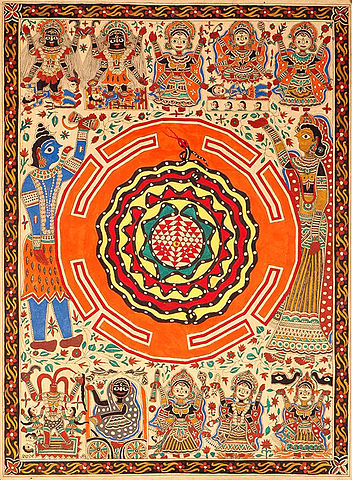 Madhubani Painting
Madhubani Painting
Madhubani paintings traditionally deal with the themes from Ramayana, Mahabharata, and paintings of Gods like Radha Krishna, Shiva Parvati, Maa Durga, Ganesh, Buddheshwar, Raja Salesh, and Jutki Malini. They also show natural village life, flora fauna, and other natural scenes.
The art form is mainly practiced in the villages of Jitwarpur, Ranti, Rasidpur, Bacchi, and Rajangargh.
Earlier Madhubani paintings were made using natural dyes and colors, like white from ground rice, black from lamp soot, green from the leaves of the apple tree, Blue from the seeds of Sikkot, red from Kusum flower, and red sandalwood.
In the current day, Madhubani paintings are made of a variety of materials. Like oil painting on canvas, acrylic painting, handmade paper, and fabrics like silk.
Stylistically, Madhubani paintings can be categorized as geru, bharhi, kachni, gobar, and godna.
Artists pursuing Madhubani paintings have won many awards and recognition from both the Bihar state Government as well as the Union Government. Artists like Sita Devi won Padma Shree in 1981 and was also awarded Bihar Ratna Award in 1984, Jagadmba Devi was awarded the Padma Shree in 1975, artist Mahasundari Devi won Padma Shree in 2011, and artists Dulari Devi won Padma Shree in 2020.
Madhubani paintings have won international acclaim also, with many artworks getting exported. These paintings make for great souvenirs and gifts and home décor.
Conclusion
This post is an attempt to highlight the Indian folk art traditions, the depth of her variety and style of handmade paintings, and an enviable heritage that harks back to millennia. The art experience of India is truly underappreciated. In the future, we will update this post with a few more stunning folk art of India. '
About Us:
Paintphotographs.com is India's leading custom art platform. We turn your favorite photos, pics, and images into luxurious handmade portrait paintings. Our work includes handmade portraits, custom oil reproductions, charcoal drawings, and sketches. As a team of accomplished artists, we use museum-quality canvas, best international brands of colors such as Winsor & Newton and Daler Rawney. We work with various mediums, including oil, acrylic, mixed media, graphite, and charcoal.
To order a custom handmade oil portrait painting you can visit our order now page. You can order custom Wedding Paintings, Couple Paintings, Memorial Paintings, Family Paintings, Baby portraits and Children Paintings, Photo to paintings, and Pet Portrait Paintings from Photo.
You can visit our pricing page to know the prices of our portrait paintings. To connect with us ping us on our chat messenger on the website, ping us on WhatsApp, call us at918291070650, or drop us an email at support@paintphotographs.com
You can visit our gallery pages to see our work. We make single portrait paintings, couple paintings, memorial paintings, Kids and Baby Portrait paintings, God & Religious Paintings, Old Photo to Paintings, Wedding couple Paintings & Marriage Portraits, Family Paintings, Pet Portrait Paintings, Radha Krishna Paintings, Oil Portraits of Gurus, Saints & Holy Men, Charcoal and Pencil Sketches, Custom Landscape & Cityscape paintings, Contemporary Art Reproduction & Replica Paintings, Old Master Reproduction & Replica Art, Monochrome and Black & White portrait paintings, Historical Portraits and Shivaji Maharaj Paintings, Celebrity & Political Leaders Portraits. We can also merge separate photos to create a single seamless painting called Composite portraits to add deceased loved ones to make a family oil portrait as though they were present.
Our custom handmade portraits make beautiful Anniversary Gifts, Engagement Gifts, Birthday Gifts, Retirement Gifts, Housewarming Gifts, Mother's Day gifts, and luxurious gifts for many important occasions.
Paintphotographs.com provides bespoke services for art patrons, interior designers, and architects. It helps you create the perfect pieces for residential and commercial projects and serves as a platform for artists to showcase their work.
If you are an art aficionado interested in writing a guest post on art, connect with us.
For sources referenced in the article, please refer to the Notes and Reference section.
Like this story? Then you will love our podcasts on Spotify. Listen to our deep dives and fascinating stories from the art world.
Join our nearly 20,000-strong community on Facebook, WhatsApp, and X.
Want to see our art? Join our community of 500,000+ subscribers on the Paintphotographs YouTube channel, Instagram, and Pinterest for some amazing art pics & art videos!
Notes, References, and Further Readings:
Old Chitrakathi Art — Google Arts & Culture
Uses of Plants and Plant Products in Traditional Indian Mural Paintings | SpringerLink
(PDF) COLOUR CULTURE AND IDENTITY: INFLUENCE OF COLOURS ON KERALA MURAL ART
A Reappraisal of Rock-art at Vellarikombi and its Kurumba Association and Continuity
[PDF] The Mandala of the Present Moment | Semantic Scholar
মাসান/Masan - Canvas Paintings and Cork Dolls | INDIAN CULTURE
Nirmal Paintings - Arts and Crafts

